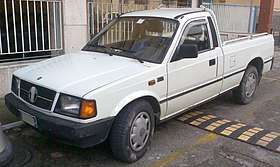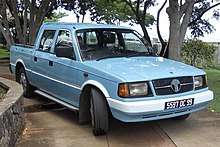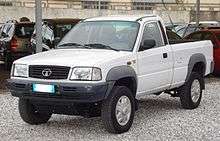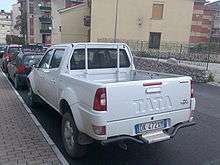Tata Telcoline
Tata Telcoline is a mid-size pickup truck made by the Indian automaker Tata Motors since 1988. In India it was originally known as the Tatamobile 206 and from 2002 the name was changed in Tata 207 DI. In export market was sold as a Tatamobile, Tata Loadbeta or simply Tata Pick Up.
| Tata Telcoline | |
|---|---|
Second generation | |
| Overview | |
| Manufacturer | Tata Motors |
| Production | 1988-present |
| Body and chassis | |
| Body style | 2-door pick-up 4-door pick-up |
First generation (1988-present)
| Tata Telcoline | |
|---|---|
 | |
| Overview | |
| Also called | Tatamobile 206 Tata Pick-Up Tata 207 Tata TL Tata Loadbeta |
| Production | 1988–present |
| Assembly | Pune, India Pekan, Pahang, Malaysia |
| Body and chassis | |
| Layout | Front-engine, rear-wheel-drive Front-engine four-wheel-drive |
| Platform | Tata X2 |
| Related | Tata Sierra Tata Estate Tata Sumo Tata Safari |
| Powertrain | |
| Engine | 2.0L Peugeot XD88 diesel I4 2.2L Dicor diesel I4 3.0L 4SP diesel I4 3.0L Dicor diesel I4 |
| Transmission | 5-speed manual |
| Dimensions | |
| Wheelbase | 2,825–3,150 mm (111.2–124.0 in) |
| Length | 4,585–5,210 mm (180.5–205.1 in) |
| Width | 1,700–1,810 mm (67–71 in) |
| Height | 1,600–1,730 mm (63–68 in) |
| Curb weight | 1,715–1,995 kg (3,781–4,398 lb) |
Introduced in July 1988, the Tatamobile 206 pick-up (the original name used in India) was designed and engineered by Telco (Tata Engineering and Locomotive Company) and was the first light commercial vehicle launched by Tata Motors after the heavy duty Tata 407 (a vehicle based on the Mercedes-Benz T2 design). Developed in two years[1] the pick up sold a total of 61,691 examples in India in the 1988-1989 model year and 64,941 vehicles between 1989–1990. With the Tatamobile 206 the Indian automaker acquired 25% of the market share in the light commercial vehicle segment.[2]

The Tatamobile 206 is a mid-size pick-up produced on a flexible body-on-frame chassis (called Tata X2 platform[3]) in both short wheelbase (single-cab, 2 seats) and long wheelbase (crew-cab, 5 seats) with rear or four wheel drive: the 4WD version has a higher ground clearance for improved off-road use. On the same X2 platform Tata Motors produced the compact 3-door SUV Tata Sierra (launched in 1991), the 5-door wagon Tata Estate and the 5-door SUV Safari, Sumo and Spacio. Originally in India it was powered by a naturally aspirated 2.0 litre (1.948 cc) diesel Peugeot XD88 engine (assembled under license by Tata in India) that produced 63 HP, in 1994 a re-engineered turbocharged version of 2.0 litre Peugeot engine was added that produced 92 HP.
In 1990 Tata started to export the Tatamobile to South Africa with the name Telcoline and in 1994 Tata introduced a face-lift to the Indian market with revised front lights. Tata also began to export the vehicle to Europe. In Italy, it was sold as the Tata Pick-Up in single and crew-cab form with two trim levels: base level and Orciari, a more equipped version created by Italian firm Orciari with two-tone paint, front bull-bar, alloy wheels, air conditioning and a more refined interior. The engines available in Europe were the 2.0 litre Peugeot naturally aspirated diesel (63 HP) and turbo diesel (92 HP), with the introduction of the Euro 3 emission standard, the naturally aspirated version was phased out and the power of turbocharged version was reduced to 88 horsepower.[4]
In 2000 Tata Motors signed an agreement with Malaysia Truck & Bus (MTB) to assemble the Telcoline in complete knock down kit form in the Pekan, Pahang plant in Malaysia, for sale on the local market. The pick-up was initially sold only in the 4WD double-cab version, though later the single-cab version was also introduced.[5]
2002 facelift

In August 2002 a more substantial facelift was introduced: new front and rear bumpers make their debut, new bonnet and front grille that houses the new Tata logo, moreover changes are made to the mechanics and the new 3,0 diesel engine is introduced (the same used in the Tata 407[6]). With the new engine Tata changed the name in the Indian market from Tatamobile to Tata 207 DI. The 3.0 litre (2956 cc) naturally aspirated diesel produced 58 HP but had more torque than the outgoing 2.0 litre Peugeot, while the turbocharged version produced 87 HP and was homologated to meet Euro 4 regulations.[7]
In September 2003 a joint venture was signed between Tata Motors and Phoenix Venture Holdings (MG Rover group) for the distribution and sale of the Tata 207 DI in the United Kingdom.[8] In 2006 Tata introduced to the Indian market the 207 DI EX,[9] a single cab version with flat load body and long wheelbase. In Europe the new 2.2 litre Dicor turbodiesel common rail engine Euro 4 that produce 140 horsepower was introduced.[10][11] The 2.2 litre was based on the design of the 2,179 cc PSA DW12 engine and was re-engineered by Tata and AVL.
In 2005, for the first time, Tata introduced the four-wheel drive version of the Telcoline in India. It had previously only been produced for export markets.[12] In India the 4WD version was sold as the Tata TL, the rear-wheel drive version continued as the Tata 207. In 2008 export to Europe was ended, with Tata announcing its successor the Xenon pick-up.
Today production continues in India, with export to South Africa.
Second generation (2007-present)
| Second generation | |
|---|---|
.jpg) | |
| Overview | |
| Also called | Tata Xenon Tata TL Sprint |
| Production | 2007–present |
| Assembly | Pune, India Thonburi, Bangkok, Thailand (TAAP) Bangchan, Bangkok, Thailand (BGAC) Pekan, Pahang, Malaysia[13] |
| Body and chassis | |
| Layout | Front-engine, rear-wheel-drive four-wheel-drive |
| Platform | Tata X2 |
| Related | Tata Sumo Grande |
| Powertrain | |
| Engine | 2.1L MPFi 486PL 16V petrol I4 2.1L MPFi 486PL 16V CNG I4 2.2L VTT Dicor diesel I4 3.0L Dicor turbodiesel I4 |
| Transmission | 5-speed manual 6-speed automatic |
| Dimensions | |
| Wheelbase | 2,850–3,150 mm (112–124 in) |
| Length | 4,800–5,125 mm (189.0–201.8 in) |
| Width | 1,860 mm (73 in) |
| Height | 1,730–1,833 mm (68.1–72.2 in) |
| Curb weight | 1,750–1,950 kg (3,860–4,300 lb) |

Developed in 18 months the new generation of the Tata pickup uses an evolution of the previous body-on-frame X2 platform, revised above all in the suspension geometry, the body uses a higher percentage of high-strength steel. Given the success of the previous Telcoline, with the new series Tata realizes a product intended primarily for export in many countries including ASEAN, EMEA and Merconsur in fact is being equipped with double front airbags and security systems such as ABS, control traction and speed downhill. During the development phase it is called TL Sprint due to the reduced industrialization times. Following the launch, ESP stability control is also introduced for export.
.jpg)
The presentation takes place in the form of a definitive prototype at the Bologna Motor Show in December 2006, the production starts in May 2007 at the Pune plant (India) and immediately begins sales in both India and Europe and South Africa. The final name chosen by Tata Motors is Xenon to avoid confusion with the previous Telcoline left in production.[14] In Europe it is equipped with the new 2.2 liter Dicor turbodiesel common rail Euro 4 delivering 140 horsepower and a 5-speed manual transmission.
In India its revised X2 platform also gives rise to the Tata Sumo Grande.
In 2012, with the introduction of the Euro 5 regulations in Europe the 2.2 Dicor engine was revised with the introduction of VGT, DPF filter and the power rises to 150 horsepower.[15][16]
In 2010 the pick up starts assembled in Thailand by Tata-Thonburi joint venture.[17] In 2011 the CNG version was launched in Thailand powered by a new 2,1 litre straight-4 DOHC engine with 115 HP.[18] A variant, Xenon XT (Cross Terrain) double cab 4-door, 5-seater was launched in 2009. The Xenon has been well received in Europe especially in Spain and Italy[19]
Sales
| Year | Thailand |
|---|---|
| 2014 | 962[20] |
| 2015 | 738[21] |
| 2016 | 923[22] |
| 2017 | 598[23] |
| 2018 | 447[24] |
| 2019 | 478[25] |
References
- "Telco gears up to make grand entry into passenger car market with launch of new vehicle". IndiaToday.in. 31 August 1988. Retrieved 25 June 2018.
- Tatamobile 206 history
- "Rebuilding success stories". Tatawestside.com. April 2003. Retrieved 25 June 2018.
- "Archivio veicoli commerciali leggeri: Tata Pick Up". TuttoTrasporti.it. Retrieved 30 June 2018.
- "New Car Launches: Tata Telcoline 207 4×4 Crew Cab". autoworld.com.my. 25 September 2000. Retrieved 1 August 2018.
- "Tata 207 to have 407's engine". Tatawestside.it. 8 January 2002. Retrieved 30 June 2018.
- "Tata Engineering launches Tata 207 DI featuring optimum performance direct injection engine". Tatawestside.it. 14 August 2002. Retrieved 30 June 2018.
- "MG Rover mulls Tata Indica diesel sourcing too". Tatawestside.com. 17 September 2003. Retrieved 30 June 2018.
- "Tata Motors' new model". Tatawestside.com. 10 January 2006. Retrieved 30 June 2018.
- "Archivio veicoli commerciali leggeri: Tata Pick Up 2.2 Dicor 16V 4x2 PL-DC". TuttoTrasporti.it. Retrieved 30 June 2018.
- "Nuovo Tata Pick Up. A voi la scelta..." La Repubblica. 5 March 2007. Retrieved 31 August 2018.
- "Tata Motors introduces the power-packed Tata TL 4x4". Tata Motors. 8 December 2005. Retrieved 31 August 2018.
- Tata Malaysia CKD programme
- Tata TL Sprint will be called Xenon
- Archivio listino Tata Xenon Italia
- Tata Xenon Euro 5 diesel
- Tata Motors & Thonburi of Thailand set up joint venture in Thailand for pickup trucks Archived 2010-12-06 at the Wayback Machine
- Tata Will Unveil The Xenon Super CNG At Motor Expo
- re (2008-01-13). "italiaspeed.com". italiaspeed.com. Retrieved 2010-02-24.
- "Thailand cars sales report 2014". HeadlightMag.com. Thailand. Retrieved 24 Oct 2018.
- "Thailand cars sales report 2015". HeadlightMag.com. Thailand. Retrieved 24 Oct 2018.
- "Thailand cars sales report 2016". HeadlightMag.com. Thailand. Retrieved 24 Oct 2018.
- "Thailand cars sales report 2017". HeadlightMag.com. Thailand. Retrieved 24 Oct 2018.
- "Thailand pick-up sales report 2018". HeadlightMag.com (in Thai). Thailand. Retrieved 22 Jan 2019.
- "Thailand pick-up sales report 2019". HeadlightMag.com (in Thai). Thailand. Retrieved 25 Feb 2020.